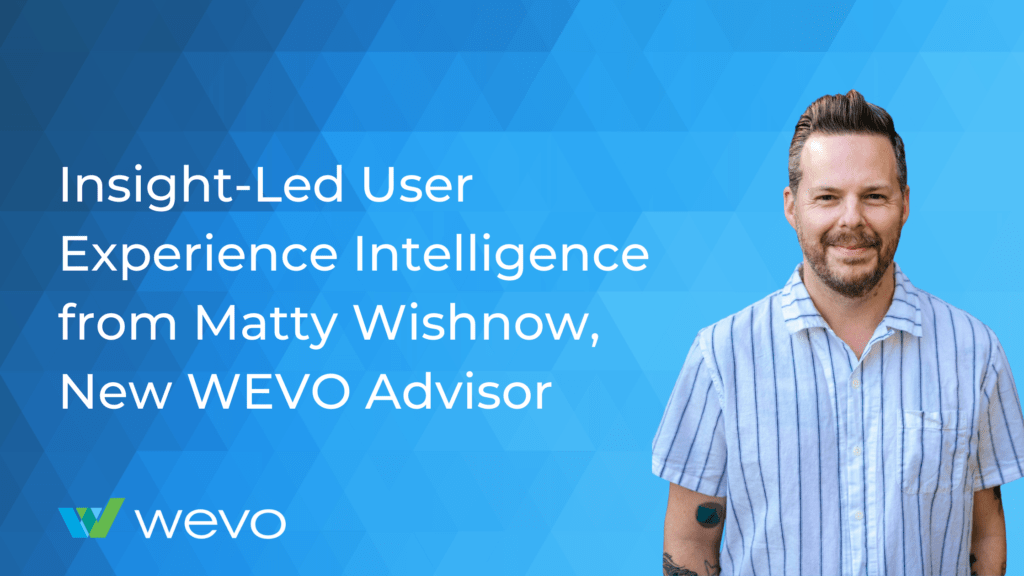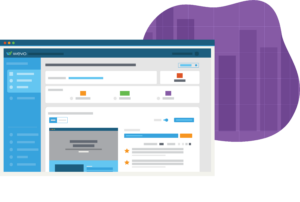Contents
- 1 Q&A On The Evolutions of User Experience
- 1.1 What do you think is the biggest shortcoming of today’s user experience practices?
- 1.2 How have current events changed the practice of experience design – good and bad?
- 1.3 When creating and optimizing digital experiences, what are some of the top challenges you still see product, marketing and design teams struggle with?
- 1.4 With your background, what advice would you give teams looking to expand their user research efforts and become an insight-led organization?
- 1.5 What are some industry-leading examples of insight-led organizations and what do they get right?
Q&A On The Evolutions of User Experience
A recognized User Experience industry leader, Matty Wishnow is the newest WEVO Advisory member, providing his expertise to help organizations solve more problems and create more value for their customers. With his breadth of experience as former Managing Director of Experience Design and Optimization at Accenture and Co-Founder of Clearhead, Matty shared his take on leading user experience hurdles and how organizations focusing on becoming insight-led are tackling user experience effectively.
What do you think is the biggest shortcoming of today’s user experience practices?
I believe that innovation and experimentation practices have gotten much better at understanding “the what” of their work at the expense of “the why.” Billions of dollars are spent on digital experiences without anyone really knowing if, and more importantly, why certain things succeed or fail. I am so appreciative of the progress that has been made in digital analytics, research and testing — all in pursuit of better user experience design. Unfortunately, I think those tools and teams far too often either ignore or obscure the root problems that products and services actually need to solve for.
There’s a lot of intense reporting and anecdotal evidence, but not a whole lot of learning or user empathy. In general, businesses still tend to make broad leaps from ideas into solutions without ever understanding the need and the why and I think a lot of software in the market has either enabled these behaviors or been mis-used because of deeply held organizational behaviors.
How have current events changed the practice of experience design – good and bad?
As brutal as the pandemic has been for so many people and businesses, it has been inspiring to see how some companies have reimagined experiences and adopted new software or service design patterns to survive. As a result, businesses not traditionally known for great digital user experiences have leveled up their sales, service and communications. In general, this has been great for the end user. However, it has also reset expectations so that customers expect everything to be as frictionless as the products that have reshaped our lives — Zoom and Shopify and Instagram and Apple Pay. That’s a very high bar for most businesses.
When creating and optimizing digital experiences, what are some of the top challenges you still see product, marketing and design teams struggle with?
There’s the functional challenge of siloed teams using disparate products and processes in pursuit of a common goal — better user experience. Experience and product design are still relatively new capabilities for most businesses and so the organizational design around them is often immature and inefficient. However, I think the larger challenges still relate to business cultures that are dominated by gut or force of will or charisma or legacy behaviors rather than evidence and user empathy.
With your background, what advice would you give teams looking to expand their user research efforts and become an insight-led organization?
To quote Ryan Holiday’s book, “the obstacle is the way”. The only way to find the solution is through the problem. So, while most businesses are obsessed with ideas and projects and, occasionally, hypotheses, they are unlikely to succeed without a proper diagnosis of the root problems they are trying to solve. It is very natural for humans to pursue closure and to confirm their own biases. And, frankly, when aimed towards the end result rather than the obstacle, a lot of analytics and research can make these pitfalls more prevalent. So, my advice is to reorient teams and their activities around problem understanding.
A redistribution of capacity and investment towards the obstacle ensures that the eventual solutions are more likely to solve for the user and, therefore, more likely to succeed for the businesses. This idea of focusing more on the problem than the solution is uncomfortable for most businesses, but I believe it’s the difference between companies that are genuinely great, and everyone else.
What are some industry-leading examples of insight-led organizations and what do they get right?
Amazon would be the obvious example. They’ve pioneered both in terms of culture of experimentation and problem-led innovation. I think Google is nearly as great and perhaps even better with their more recent emphasis on design and design thinking. I notice AirBnb designing and innovating on the basis of user desire. In fact, their formative hypothesis — short term rentals that are driven by renter’s needs rather than owner’s needs — was obvious, necessary and almost rendered their closest competition obsolete.
That all being said, I’ve been amazed to see how small businesses — and especially restaurants — have pivoted during the pandemic to respond to changing behaviors and rapid insights. There are some small businesses here in Austin, TX that have thrived during the pandemic specifically because they paid close attention to what their customers most desired and what the newest and biggest problems were that stood in between them. QR code menus, frictionless takeout, makeshift drive throughs, better outdoor seating and margaritas to go were all born from better understanding of dining in the pandemic.



